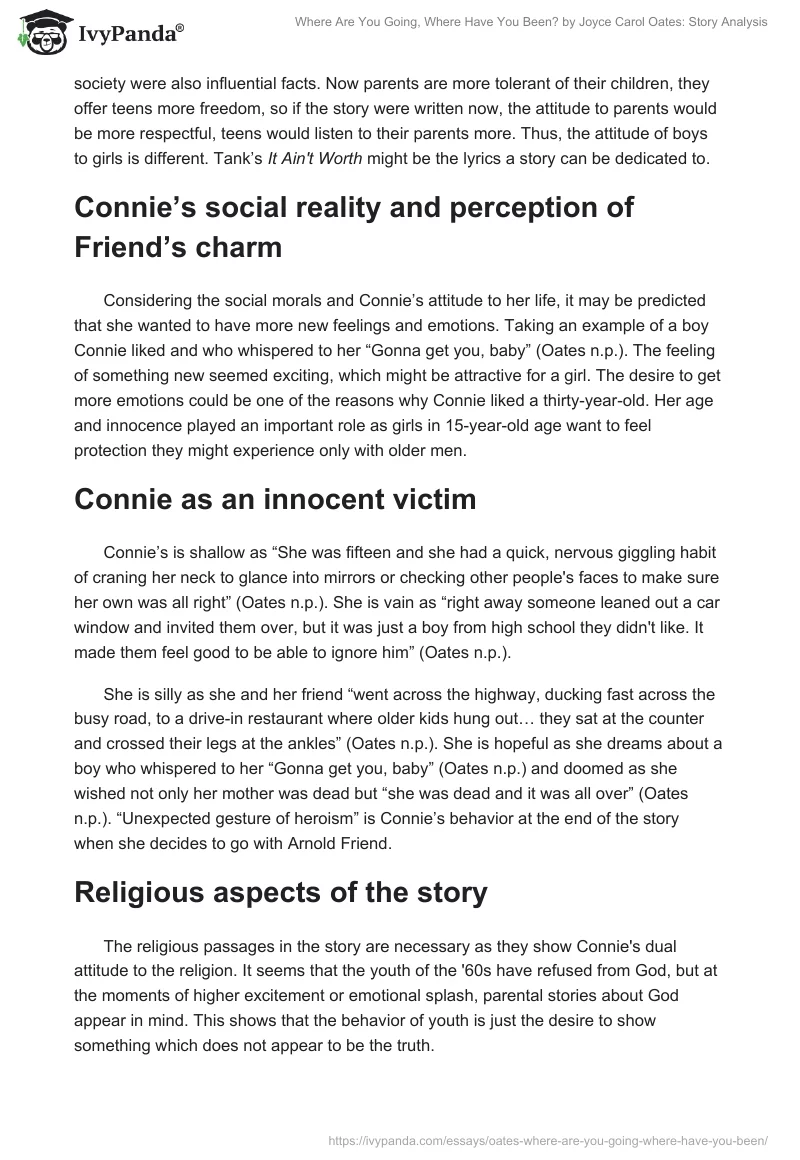Oates’ “Where Are You Going, Where Have You Been?” in relation to Bob Dylan’s song “It’s All Over Now, Baby Blue”
The end of Oates’ story is ambiguous as there is no specific answer to what will happen. Connie has just left her front porch. This is the information we can consider. Arnold Friend’s final words were said in a half-sung sigh “My sweet little blue-eyed girl” (Oates n.p.). These words are taken from the song by Bob Dylan. The whole story was written under the influence of this song. One of the main ideas of the song is security, as a girl in the song is offered to take what she needs and walk away, being sure that everything is going to be good.
The same feeling of security and better opportunities Arnold Friend wants to deliver to Connie, to make her understand that by being with him she is going to be protected. These words from the song made me understood that the author of the story wanted to show that Connie and Arnold were created for each other and they had to be together even though Arnold Friend had to frighten a girl and make her return to him.
The new morality of the ’60s as the setting of Oates’ story
The time when the story was written coincides with the change of morals people had. Youths’ behavior became unbearable, they did not want to listen to their parents, all that elder people believed in was ruined. This attitude to life is reflected in Connie’s behavior, “Connie’s mother kept picking at her until Connie wished her mother was dead” (Oates n.p.). The sexual revolution in the ’60s and the desire to go against society were also influential facts. Now parents are more tolerant of their children, they offer teens more freedom, so if the story were written now, the attitude to parents would be more respectful, teens would listen to their parents more. Thus, the attitude of boys to girls is different. Tank’s It Ain’t Worth might be the lyrics a story can be dedicated to.
Connie’s social reality and perception of Friend’s charm
Considering the social morals and Connie’s attitude to her life, it may be predicted that she wanted to have more new feelings and emotions. Taking an example of a boy Connie liked and who whispered to her “Gonna get you, baby” (Oates n.p.). The feeling of something new seemed exciting, which might be attractive for a girl. The desire to get more emotions could be one of the reasons why Connie liked a thirty-year-old. Her age and innocence played an important role as girls in 15-year-old age want to feel protection they might experience only with older men.
Connie as an innocent victim
Connie’s is shallow as “She was fifteen and she had a quick, nervous giggling habit of craning her neck to glance into mirrors or checking other people’s faces to make sure her own was all right” (Oates n.p.). She is vain as “right away someone leaned out a car window and invited them over, but it was just a boy from high school they didn’t like. It made them feel good to be able to ignore him” (Oates n.p.).
She is silly as she and her friend “went across the highway, ducking fast across the busy road, to a drive-in restaurant where older kids hung out… they sat at the counter and crossed their legs at the ankles” (Oates n.p.). She is hopeful as she dreams about a boy who whispered to her “Gonna get you, baby” (Oates n.p.) and doomed as she wished not only her mother was dead but “she was dead and it was all over” (Oates n.p.). “Unexpected gesture of heroism” is Connie’s behavior at the end of the story when she decides to go with Arnold Friend.
Religious aspects of the story
The religious passages in the story are necessary as they show Connie’s dual attitude to the religion. It seems that the youth of the ’60s have refused from God, but at the moments of higher excitement or emotional splash, parental stories about God appear in mind. This shows that the behavior of youth is just the desire to show something which does not appear to be the truth.
Works Cited
Oates, Joyce Carol. Where Are You Going, Where Have You Been? Web.


